2018 Kawasaki H2 SX SE First Ride Review
It’s funny how time’s arrow flies. Seems like only yesterday we were in a chill and rainy Milano for the big international motorcycle exposition, drooling over the showstopping new Ninja H2 SX SE with Sean Alexander and Brent J., knocking out non-award-winning videos and wondering what Kawasaki could possibly be thinking to produce such an outrageous motorcycle? Shirley it will be way expensive and unobtainable like the other H2s?
2018 Kawasaki Ninja H2 SX
| Engine | 20/20 |
| Suspension/Handling | 14.5/15 |
| Transmission/Clutch | 9.75/10 |
| Brakes | 9.75/10 |
| Instruments/Controls | 4.75/5 |
| Ergonomics/Comfort | 9.5/10 |
| Appearance/Quality | 9.75/10 |
| Desirability | 9.75/10 |
| Value | 9.5/10 |
| Overall Score | 97.25/100 |
EICMA: 2018 Kawasaki H2 SX SE First Look
2015 Kawasaki Ninja H2 First Ride Review
Lo and behold, here it is four months later and 6000 miles removed, and it’s just me flogging the green beastie up and down my favorite test circuit under clear desert skies – and I only am escaped alone to tell thee… not only is the H2 SX SE only $22,000, the base model’s just $19k. I hate to break the news, but that’s what a premium motorcycle costs now.
Get the Flash Player to see this player.
I’ve forgotten exactly what backroom machinations culminated in MO getting the exclusive North American first-ride scoop on the SX, but it’s best just to say thank you, Sean A. and Kawasaki, and not look this gift horse in the mouth. On this bike, it’s best to keep one’s eyes on the road.
The big deal, of course, is the supercharger, and its main function seems to be to compress time and space along with air. The H2’s engine just never feels like it’s working all that hard beneath you, but past 7 or 8,000 rpm on the tachometer, speed seems to increase at a rising rate, and suddenly your faceshield is filled with corner – it’s the kind of speed that makes you grab the brakes too early. (Natch, we have great brakes with electronic assist that have no problem reining the beast right back in with road to spare.) Why are we rolling so slow through this perfectly paved corner, asks the Kawasaki? It takes a while to adjust, but after that, it’s very nice to have warp drive an eighth of a throttle twist away.
Yes, there are more powerful 1000cc sportbikes than this 171-horsepower one, including the 180-hp Aprilia RSV4RR and 177-hp BMW S1000RR that duked it out in last year’s Superbike Shootout. But they make their power well past 13,000 rpm; you have to work for it a little. The H2’s artificial air inseminator lets its 998cc four-cylinder produce its peak at just 10,300 rpm. And even more to the point is the fact that the H2’s blown motor is making more torque way sooner – 89 pound-feet of the stuff at just 8600 rpm. The S1000RR puts out 80 lb-ft at 9600 rpm, the Aprilia 78 at 11,300.
Well, the SX is also 100 or more pounds heftier than those true sportbikes, but in its natural habitat – fast, open roads – you’d be hard pressed to tell. That extra weight takes the form of a cockpit with room for two and a beefed-up subframe capable of carrying a 430-pound payload and saddlebags – not to mention a standard centerstand and one-sided swingarm that’ll make changing rear tires a snap (a thing you might be doing a lot). More importantly, the SX, at 576 pounds wet on the MO scales, is around 100 pounds lighter than the next step up the hard-luggage-equipped Kawasaki food chain – the 1352cc Concours 14.
Is the H2 SX a sport tourer or a sportbike? It’s having a hard time deciding. To me, it’s way more tourable than slightly more-powerful but heavier megabikes like the ZX-14R and Hayabusa. At the same time, comparing the SX to our reigning sport-touring champ BMW R1200RT would seem like an apples and oranges affair – not that we’re always opposed to those. Really, the H2’s very cool supercharger tech means the bike is carving out its own niche somewhere between sport and sport-touring. Counterintuitively, Kawasaki uses the word “efficiency” quite a bit in describing it. You can definitely get through the H2’s five-gallon fuel tank quickly when you’re blasting up and down Montezuma Grade. But when I rode the 120 miles home after two days of that, at a slightly more sedate pace, we got 42 miles per gallon. That’s way better than Aprilia V4s, BMW S1000RRs and ZX-14Rs and Hayabusas.
Sedate being a relative term here. All motorcycles seem to have a happy speed (or maybe it’s just the rider?), but the H2 seems most content when it’s rolling along with the tachometer needle at 6000 rpm. The digital speedo says that’s about 90 mph in top gear, which nobody on California backroads and freeways seems to object to much lately. Knock on wood.
From cruising speed, should the mood strike you and you find yourself alone on the road and bored, whacking the H2 SX’s throttle open seems to have the speedo into triple digits sooner than most monster bikes. Its supercharger is the same unit used in the original H2 and H2R, but its impeller blades are angled differently to produce less boost up high, more in the midrange (along with lots of other engine changes). The SX is the streetable H2, designed for real-world use instead of hyper performance and top speed: 6500 rpm seems to be where the blower starts really blowing. From 6500 to 8000 rpm we go from 95 to 130 hp, and from 77 to 86 lb-ft of torque. And from there the acceleration verges on intense even in sixth gear. It feels like the ram air duct that feeds the supercharger is really effective – a thing a stationary dyno can’t measure.
Those engine changes mean the SX runs cooler than the original H2s, so the bike’s now fully enclosed in plastic and there’s a bigger, more sheltered cockpit for the now more-upright rider, who gets to grab grips high above the top clamp instead of clip-ons mounted below it. Ergonomics, again, are neither as upright as a BMW R1200RT nor as sporty as an S1000RR – but somewhere in the middle. After two long days in the saddle, my rear end was only beginning to complain a bit from the slightly crowned saddle; the rest of me – back, shoulders and wrists felt fine. Judging from the photos, I’m going to guess that raised passenger seat will be better suited to an aspiring new friend than to a long-suffering spouse who knows where all your bones are buried – but at least the SX has a passenger seat.
Running along anywhere from 70 to 100 is absolute bliss for 5’8” me on this one, the tall bubble leaving my noggin in clean air and negating most of the weight on the wrists. If I hadn’t been told the fully adjustable suspension is from KYB, I would’ve guessed it was Swedish: supple, bump-absorbent, yet firmly in control well into the triple-digit speeds the SX is able to dial up at a few seconds notice. The shock has low- and high-speed compression adjusters I didn’t really feel the need to adjust, though I did put in a couple turns of rear preload to keep the footpeg feelers from touching down.
I’m starting to think there’s something to these steel trellis frames. Like the KTM Super Duke GT and Yamaha MT-07, the H2 SX has a certain supple organic feel that keeps you in intimate contact with the contact patches – in this case, very nice Bridgestone S21 rubber – when you start swerving through the curves: 4.1 inches of trail via 24.7 degrees rake is steeep enough, and a 58.3-inch wheelbase is short enough to keep the SX pretty light on its feet, and its modern electronics package, complete with Bosch 6-axis IMU, encourages you to channel your inner Jonathan Rea.
Again, the 43mm inverted fork and linkage-mounted shock on the SX represent some of the best suspension tuning Kawasaki’s ever done on a street bike if not the best. Mixed in with strong triple disc brakes equipped with Kawasaki’s lean-sensitive Intelligent Braking System and KTRIC three-level traction control (which is easy to turn off if you insist), the SX feels like it would be a match for any motorcycle on the fast, flowing roads it prefers. All its systems work seamlessly together to let you pay attention to the road from the minute you hit the starter button.
For some reason, the SX’s burly exhaust note seems relatively quiet, its slip/assist slipper clutch gives the lever a nice, light pull – and the quickshifter on the SE means you really don’t need to touch it again once rolling (though I instinctively use a little clutch on the 1-2 upshift). The dog-ring style six-speed gearbox never misses a shift. First and second are taller than on the H2, and this is the first Kawasaki I’ve ridden that will allow you to shift into second from neutral if you want to. In first or second, if you’re brave enough to hold the throttle wide open, the front wheel will begin coming up; luckily the SE has Launch Control Mode to keep it from coming up too far.
Some years ago, Kawasakis had a rep for being a bit crude, a little rough around the edges. This one is anything but unless you just object to green metalflake. They don’t put that rivermark logo on just any motorcycle; this one’s built to show just how nice a motorcycle Kawasaki can build. An extremely nice one, as it turns out, in addition to one that’ll blow (almost literally) the doors off 99.99% of everything else on the road. I’m pretty sure 97.5 is the highest I’ve ever ranked any bike on the MO scorecard, and the only time I’ve ever given an engine a perfect 20. I think the bar just got raised.
Stuff the SE has:
- KQS Kawasaki Quick Shifter
- KLCM Kawasaki Launch Control Mode
- Larger windscreen
- LED cornering lights
- Comfort seat
- Heated grips
- Steel braided brake lines
- Centerstand
2018 Kawasaki Ninja H2 SX SE
+ Highs
- Super Charger is just plain cool let’s face it
- Eerily smooth megamotor power from 998cc
- Seamless multi-mission performance
– Sighs
- Defies easy classification
- The world probably needs a blown Versys 650 more
- Posted speed limits seem more ridiculous than ever
2018 Kawasaki Ninja H2 SX SE Specifications | |
|---|---|
| Engine Type | 4-stroke, 4-cylinder, DOHC, 4-valve, liquid-cooled, supercharged |
| Displacement | 998cc |
| Bore x Stroke | 76.0 x 55.0mm |
| Compression ratio | 11.2:1 |
| Horsepowe | 171.7 at 10300 rpm as measured on Dynojet 250i |
| Torque | 89.1 at 8600 rpm as measured on Dynojet 250i |
| Fuel System | DFI with 40mm throttle bodies (4) with dual injection |
| Ignition | TCBI with digital advance |
| Transmission | 6-speed, return, dog-ring |
| Final Drive | Sealed chain |
| Electronic Rider Aids | Kawasaki Corner Management Function (KCMF), Kawasaki Traction Control (KTRC), Kawasaki Launch Control Mode (KLCM), Kawasaki Intelligent anti-lock Brake System (KIBS), Kawasaki Engine Brake Control, Kawasaki Quick Shifter (KQS) (upshift & downshift), Öhlins Electronic Steering Damper, Cruise Control, LED Corning Lights |
| Front Suspension | 43mm inverted fork with rebound and compression damping, spring preload adjustability and top-out springs, 4.7 in. travel |
| Rear Suspension | New Uni-Trak, gas charged shock with piggyback reservoir, compression and rebound damping and spring preload adjustability, and top-out spring, 5.5 in. travel |
| Front Brakes | Dual radial-mount, opposed 4-piston monoblock calipers, dual semi-floating 320mm discs, KIBS ABS |
| Rear Brakes | Opposed 2-piston calipers, single 250mm disc, KIBS ABS |
| Front Tire | 120/70 ZR17 (58W) |
| Rear Tire | 190/55 ZR17 (75W) |
| Frame Type | Trellis, high-tensile steel, with swingarm mounting plate |
| Rake/Trail | 24.7/4.1 in |
| Wheelbase | 58.3 in |
| Overall Length | 84.1 in |
| Overall Width | 30.5 in |
| Overall Height | 49.6 in |
| Ground Clearance | 5.1 in |
| Seat Height | 32.9 in |
| Wet Weight | 576 lb as measured |
| Fuel Capacity | 5.0 gal |
| Fuel Mileage | 40 mpg as observed |
| Color Choices | Emerald Blazed Green/Metallic Diablo Black |
| Warranty | 12 Month Limited Warranty Kawasaki Protection Plus (optional): 12, 24, 36 or 48 months |
More by John Burns



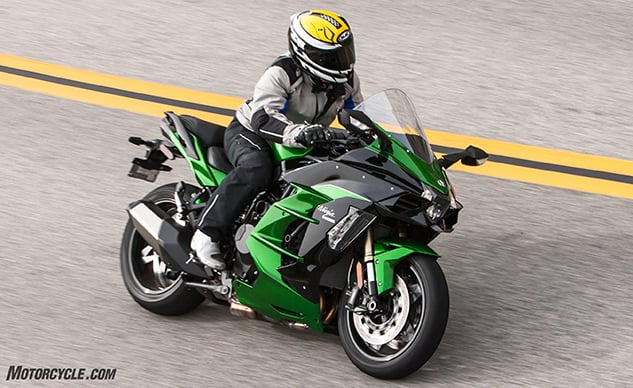
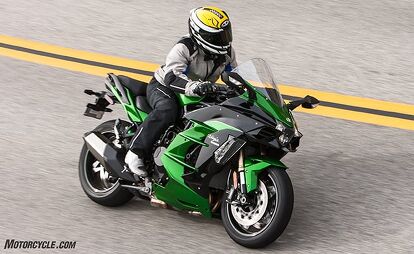



































































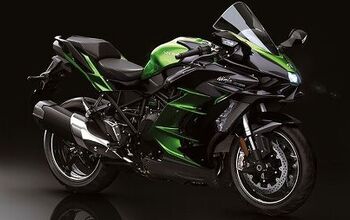


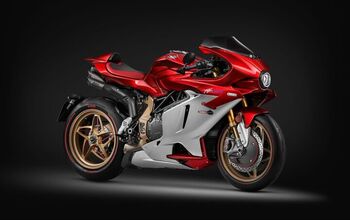
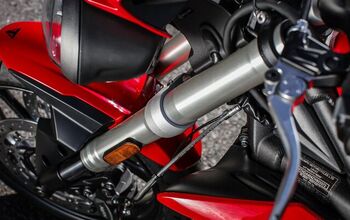


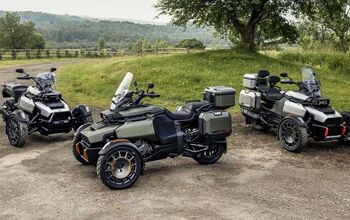


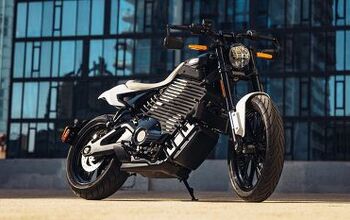
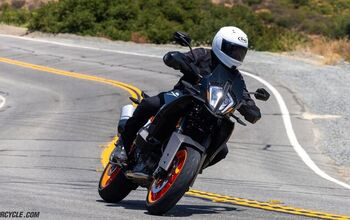

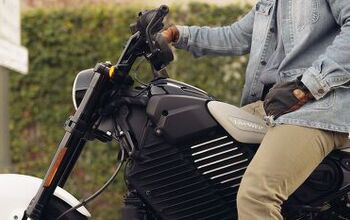
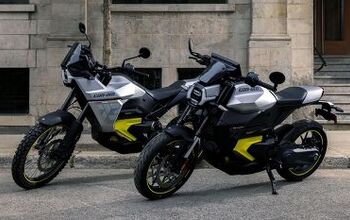
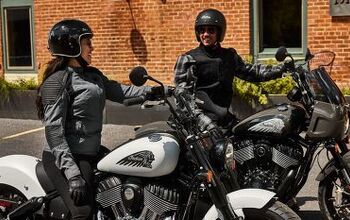

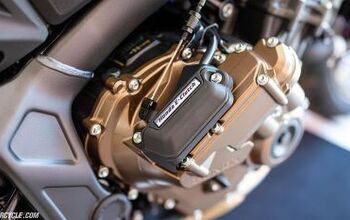
Comments
Join the conversation
Took delivery of mine a couple days ago. Fabulous bike.
Hey @disqus_nCmctsf938:disqus. I bought a 2022 based on your review. I was pushed over the edge with the adaptive cruise and the updated paint and bodywork. I'm at the age where I get out of tickets simply by removing my helmet and the "man" sees an old dude. So I truly understand the demographic that this bike was aimed at. Riders with a desire for sport riding but a body that shouts, "COMFORT IS THE NEW SPEED!" Yes sir, this bike delivers the pace without any drama. So easy to enjoy a spirited ride and feel that Skyhook suspension deliver plush yet controlled handling. As a former club racer that now feels every air fence impact and highside, I missed this type of riding. The '16 R1 was a trip at the track but it was my last pure sport bike. This is the first time I have gushed about a motorcycle since my first track day on that R1. Superlatives of a pro reviewer like yourself seem to be seasoned with Kawi-USA appreciation. But then I bought one and rode it. No test rides. Just pony up the near $30K to get one out the door and hope to hell it lives up to the hype. Well the motor is cool and all. Yes the chirp of the supercharger is "neato", but the ride of this bike is inspired. The whole package is more than the sum of its parts. It flat out exceeded my expectations. The comfort at pace is the key. Comfort is the new speed. (Ya hitting 60 in a few days. Happy Birthday to myself) Thanks for helping me spend my money. :)